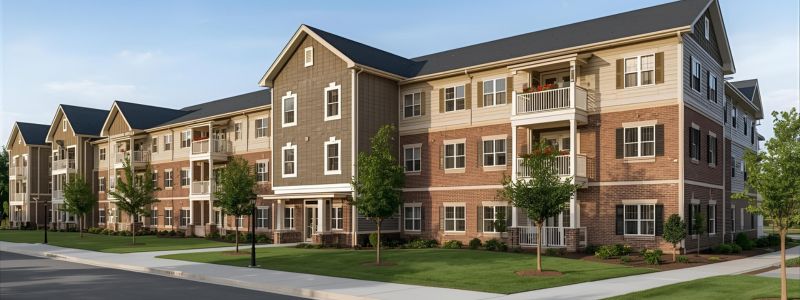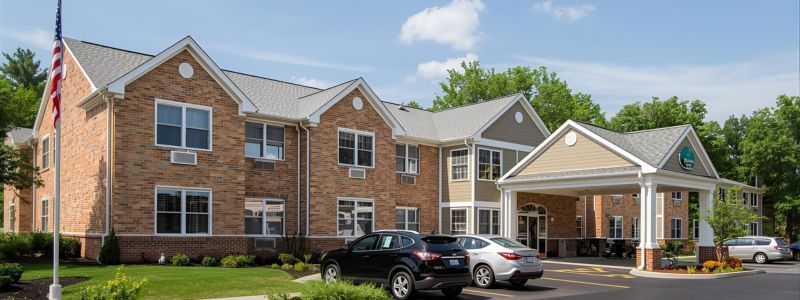
Choosing the right location for an assisted living community can feel overwhelming when you ask yourself, “what should I consider when comparing assisted living options based on location?” You want a place that supports emotional well-being, medical needs, daily convenience and long-term comfort without sacrificing your loved one’s independence.
In this guide, you’ll discover how proximity to family and social support, access to healthcare, local amenities, safety and climate, cost factors and community type all influence quality of life. You’ll also learn practical evaluation tools and where Age Well Now’s Find Care resource can help you compare senior living communities near you. By the end, you’ll have a clear framework to make confident, personalized decisions that meet both daily routines and future care transitions.
The Crucial Role of Proximity to Family and Social Support in Assisted Living
Proximity to family and social support directly enhances emotional health by reducing feelings of isolation and encouraging frequent visits that foster a sense of belonging. Being near loved ones strengthens mental well-being through shared meals, milestone celebrations and spontaneous interactions.
For example, a daughter living within a 15-minute drive can drop in for weekly card games, reinforcing bonds and reducing anxiety about long-term care decisions. Understanding this connection establishes how location underpins both practical and emotional support networks.
Improving Senior Well-Being and Emotional Health Through Family Proximity
Being close to family members helps seniors feel valued and connected, which supports mood stabilization, reduces depression and bolsters cognitive function through regular conversation. Familiar voices and shared history trigger positive memories and reinforce identity, helping to slow cognitive decline.
This consistent emotional reinforcement often translates into better sleep patterns, healthier eating habits and greater willingness to participate in community events. The daily reassurance of a supportive network inspires confidence in navigating new routines.
What Are the Best Ways to Maintain Family Connections in Assisted Living?
Below is a list of effective strategies for keeping relationships strong once a move is complete:
- Schedule regular in-person visits to transform routine check-ins into meaningful shared experiences.
- Establish video-chat rituals for daily or weekly virtual gatherings that bridge geographic distances.
- Encourage family participation in community events to integrate loved ones into social activities.
- Create a shared digital photo album to spark conversations and celebrate milestones together.
- Coordinate multi-generational outings in nearby parks or restaurants to build new memories.
These practices ensure ongoing engagement, which makes proximity more than just a matter of miles—it becomes a dynamic support system for daily life.
Variations in Social Engagement Opportunities by Assisted Living Location
Socialization options differ widely across urban, suburban and rural settings because population density, community design and cultural offerings shape available activities. Urban locations often feature organized clubs, cultural centers and intergenerational programs right next door, while suburban sites may rely on shuttle services to local arts or volunteer opportunities.
In rural areas, smaller resident groups foster close-knit friendships and encourage outdoor gatherings amid natural settings. Matching your loved one’s personality to the right social environment ensures they receive appropriate stimulation and form lasting relationships.
The Importance of Access to Healthcare Services in Assisted Living Locations
Access to healthcare services defines the safety and responsiveness of an assisted living community. Proximity to hospitals, clinics and specialist practices reduces emergency response times and ensures routine care plans are honored without long commutes. For instance, having a geriatrician’s office within five miles means faster medication adjustments and more timely interventions. When location supports medical continuity, seniors maintain health stability and families gain peace of mind.
What Healthcare Facilities Should Be Nearby an Assisted Living Community?
Before committing, verify that each facility is within easy reach by listing essential providers:
- Hospital Emergency Department within a 10-minute drive for urgent care needs.
- Primary Care Clinic that specializes in geriatric medicine for routine check-ups.
- Pharmacy Services offering prescription delivery or on-site dispensary access.
- Specialist Practices such as cardiology and neurology to manage chronic conditions.
- Rehabilitation Center for physical, occupational or speech therapy programs.
Impact of Proximity to Emergency and On-site Medical Support on Senior Safety
When a community includes 24-hour on-site medical staff or partners with a nearby urgent care center, it greatly reduces the time between incident and intervention. Rapid response teams can address falls, sudden illness or medication errors immediately, lowering the risk of complications. Having an on-site nurse station acts as a first line of defense, while nearby hospitals back up acute care needs. This layered approach delivers both preventive monitoring and emergency readiness.
What Are the Differences Between On-site Medical Care and Nearby Healthcare Providers?
Below is a comparison of models for delivering medical support:
| Service Model | Scope of Care | Typical Response Time | Primary Benefit |
|---|---|---|---|
| On-site Medical Staff | Medication management and basic triage | Immediate | Continuous monitoring and early alerts |
| Nearby Healthcare Center | Full diagnostic and treatment services | 5–15 minutes by transport | Access to specialized equipment and labs |
Local Amenities and Community Features for Seniors in Assisted Living

Quality of life in assisted living extends beyond the building into the surrounding neighborhood. Accessible shopping, diverse dining and recreational venues support independence by enabling simple errands, social outings and fitness routines. Local parks, libraries and cultural events encourage regular engagement and prevent isolation. When daily needs and leisure options are conveniently reachable, residents maintain agency over their routines and stay motivated to explore their surroundings.
Impact of Shopping, Dining, and Recreation on Senior Quality of Life
Accessible retail and dining options promote self-sufficiency by allowing seniors to choose favorite foods, pick up personal items and engage in casual outings with friends. Recreational amenities like walking trails, community gardens or movie theaters support physical health and mental stimulation. These elements combine to create a vibrant lifestyle where residents can pursue hobbies, socialize and maintain personal autonomy without relying solely on campus activities.
The Importance of Transportation Access for Assisted Living Residents
Reliable transportation options expand opportunities beyond campus boundaries by connecting residents to medical appointments, shopping centers and family homes. Public transit stops nearby, community shuttle services and ride-share partnerships ensure seniors who no longer drive can still participate fully in community life. Accessible routes, covered sidewalks and safe pedestrian crossings further encourage walking, which boosts physical health and fosters neighborhood familiarity.
Community Engagement's Influence on Senior Happiness and Activity Levels
Community engagement—through senior centers, volunteer programs and faith-based gatherings—provides purpose and social connection. Participating in local book clubs, neighborhood watch teams or charity drives keeps residents mentally active and emotionally fulfilled. When location facilitates easy entry into community networks, seniors build friendships and contribute meaningfully, which directly correlates with higher life satisfaction and improved health markers.
Safety, Environment, and Climate Factors in Assisted Living Location Choice
Neighborhood safety, environmental quality and climate all influence daily comfort, physical activity and long-term health. Low crime rates, security measures and well-lit walkways protect residents from harm and encourage regular outdoor excursions. Clean air, green spaces and moderate temperatures support respiratory health and reduce stress. Choosing a location that aligns with personal climate preferences can prevent weather-related risks and promote consistent engagement with outdoor amenities.
What Neighborhood Safety Factors Should Families Evaluate?
When assessing security, consider the following criteria:
- Review local crime statistics to identify trends in theft, assault or vandalism.
- Verify community security protocols such as gated entrances, surveillance cameras and 24-hour patrols.
- Inspect well-maintained sidewalks, street-lighting and emergency call stations for pedestrian safety.
- Confirm staff training in emergency evacuation procedures and disaster response.
- Ask about neighborhood involvement in community watch programs to foster vigilance.
Evaluating these elements ensures residents can explore surroundings with confidence, knowing preventative and emergency measures are in place.
Climate's Influence on Senior Health and Comfort in Assisted Living
Climate affects hydration, skin health and mobility. Milder climates reduce the risk of heat-related illnesses and joint stiffness, while humid regions may exacerbate respiratory conditions. Access to indoor climate control, shaded outdoor seating and indoor recreation areas allows residents to remain active regardless of weather. Matching a senior’s health profile to the local climate safeguards comfort and minimizes seasonal health fluctuations.
The Importance of Walkability and Environmental Quality for Assisted Living Residents
Walkable communities with clean air and abundant green spaces promote daily exercise and stress reduction. Safe sidewalks, accessible parks and community gardens invite residents to take gentle walks or join group outings. Environmental quality—measured by air purity and noise levels—supports cardiovascular health and improves sleep. A walkable setting turns routine errands into healthy habits and fosters connection with the broader neighborhood.
Location's Influence on the Cost of Assisted Living Facilities
Location has a significant impact on pricing, as land values, labor costs and local regulations vary widely. Urban communities tend to charge premium rates due to proximity to hospitals, cultural attractions and public transportation. Suburban settings often balance moderate pricing with ample amenities, while rural sites may offer lower rates but require extra travel for specialized services. Recognizing these regional cost drivers helps you align budget planning with desired lifestyle features.
What Are the Regional Cost Differences Between Urban, Suburban, and Rural Assisted Living?
Below is a comparison of average monthly costs by community type:
| Community Type | Average Monthly Rate | Cost Driver |
|---|---|---|
| Urban | $5,800 | High real estate and staffing costs |
| Suburban | $4,500 | Balanced amenities and overhead |
| Rural | $3,600 | Lower land prices and wages |
How Can Families Plan Financially for Location-Based Assisted Living Expenses?
Begin by creating a detailed budget that factors in base fees, additional care charges and lifestyle spending. Identify savings sources such as retirement accounts, long-term care insurance or sale of property. Consult financial planners to explore tax-advantaged strategies and monthly or annual payment options. Forecasting costs over multiple years ensures sustainable planning and avoids unexpected financial strain.
What Financial Assistance Programs Are Available Based on Assisted Living Location?
Depending on state and local regulations, seniors may qualify for:
- Medicaid waiver programs that subsidize assisted living fees for eligible low-income residents.
- Veterans Aid and Attendance benefits covering a portion of monthly care expenses.
- State tax credits or property tax relief for older adults living in designated communities.
- Nonprofit grants from local aging services councils to help with move-in costs or security deposits.
Pros and Cons of Urban, Suburban, and Rural Assisted Living Locations

Choosing between urban, suburban and rural settings involves weighing convenience, cost and lifestyle. Urban communities offer ready access to cultural venues, public transit and specialized medical centers but often come with higher price tags and busier environments. Suburban sites balance quieter neighborhoods, moderate costs and decent proximity to services. Rural locations deliver serenity and lower rates yet require more travel for healthcare, shopping and social activities. Understanding these trade-offs helps you match personal priorities with the ideal setting.
What Are the Benefits and Challenges of Urban Assisted Living Communities?
Urban assisted living communities excel at providing immediate access to hospitals, diverse dining and arts programs. Residents enjoy vibrant sidewalks, easy ride-share connections and robust volunteer opportunities. However, higher noise levels, traffic congestion and premium rates may overwhelm some seniors. Careful evaluation of neighborhood character and noise mitigation measures helps determine if an urban pace aligns with personal comfort.
How Do Suburban Assisted Living Facilities Balance Lifestyle and Convenience?
Suburban communities often feature spacious grounds, local shopping strips and recreational centers within a short drive. They combine neighborhood quiet with regular shuttle services for medical appointments and cultural events. While transportation may not be as constant as in cities, lower rates and larger living spaces appeal to seniors seeking balance. Investigating shuttle schedules and nearby clinic partnerships ensures both convenience and peace.
Why Might Rural Assisted Living Be Suitable for Some Seniors?
Rural assisted living locations provide tranquil landscapes, lower cost structures and strong community bonds among smaller resident groups. Natural surroundings and wildlife trails encourage outdoor engagement and stress relief. The trade-off includes fewer nearby specialists and longer drives for shopping or family visits. If serenity and affordability top your priority list, rural settings can deliver a restorative environment that feels like home.
Using Location Factors for Informed Assisted Living Decisions
Integrating all location considerations into a cohesive evaluation empowers families to choose a community that meets both current and future needs. By applying a structured checklist, comparing cost drivers and projecting care transitions, you transform overwhelming options into a clear decision path. Leveraging AgeWell Now’s Find Care resource and curated guides helps you compare nearby communities side by side, ensuring that emotional, medical, lifestyle and financial priorities align.
What Checklist Should Families Use to Evaluate Assisted Living Locations?
Below is a decision checklist to guide your evaluations:
| Factor | What to Verify | Why It Matters |
|---|---|---|
| Family Proximity | Driving distance and visit frequency | Supports emotional health and belonging |
| Healthcare Access | Nearby hospitals, clinics and on-site nursing | Ensures timely treatment and monitoring |
| Local Amenities | Shopping, dining, parks and cultural venues | Maintains independence and social activity |
| Transportation Options | Public transit, community shuttles and walkways | Fosters mobility and access to services |
| Safety and Environment | Crime rates, security measures and air quality | Protects physical well-being and comfort |
| Cost and Financial Assistance | Monthly rates, subsidies and aid programs | Keeps care sustainable over the long term |
| Community Type | Urban, suburban or rural characteristics | Aligns lifestyle preferences and budget |
Location's Impact on Long-Term Senior Care Transitions and Well-Being
Choosing a location close to memory care or skilled nursing centers simplifies future care upgrades if health needs escalate. Proximity to comprehensive care networks reduces stress during transitions and keeps family involved in ongoing plans. Long-term well-being also ties to community stability—staying in the same region preserves social ties, familiar routines and local support services, boosting resilience during life changes.
Where Can You Find Resources and Tools to Compare Assisted Living Locations?
You can explore AgeWell Now’s Find Care resource to filter senior living communities by distance, price, services and amenities. Several downloadable guides walk you through neighborhood assessments and cost-comparison spreadsheets. Local aging service councils and state licensing agencies also publish inspection reports and program listings to inform your decision. Combining online tools with on-site visits ensures a thorough, personalized selection process.
Frequently Asked Questions (FAQs)
How much does location typically affect the cost of assisted living?
Location significantly impacts cost. Urban areas generally have higher rates due to increased real estate and staffing expenses, while rural areas tend to be more affordable. Suburban communities often offer a balance between cost and amenities.
Why is proximity to family so important for seniors in assisted living?
Being close to family enhances emotional well-being, reduces isolation, and strengthens mental health through regular visits and shared experiences. It provides a crucial support network that fosters a sense of belonging and security.
What kind of healthcare access should I prioritize when choosing a location?
Prioritize locations with easy access to hospital emergency departments (within 10 minutes), primary care clinics specializing in geriatrics, pharmacy services, and specialist practices for chronic conditions. On-site medical staff is also a significant benefit for immediate response.
How can I assess the safety of a neighborhood for an assisted living facility?
Evaluate local crime statistics, verify community security protocols (gated entrances, surveillance), inspect pedestrian safety features (sidewalks, lighting), confirm staff emergency training, and inquire about neighborhood watch programs.
Final Thoughts
Selecting the ideal location for an assisted living facility is a multifaceted decision that profoundly impacts a senior’s quality of life, well-being, and long-term care journey. From the emotional comfort derived from family proximity and robust social support to the practical necessities of healthcare access and local amenities, every geographical factor plays a vital role. Safety, environmental quality, and climate contribute to daily comfort and health, while regional cost differences significantly influence financial planning.
By carefully evaluating urban, suburban, and rural options against a comprehensive checklist, families can make informed choices that align with their loved one’s unique needs and preferences. Leveraging resources like Age Well Now’s Find Care tool empowers families to compare communities effectively, ensuring that the chosen location not only meets current requirements but also supports future care transitions and fosters a fulfilling, independent lifestyle. Ultimately, a thoughtful approach to location selection leads to confidence and peace of mind for both seniors and their families.

